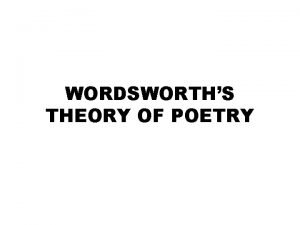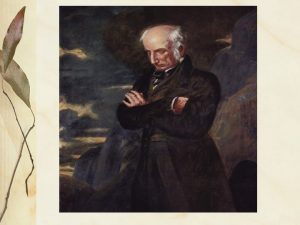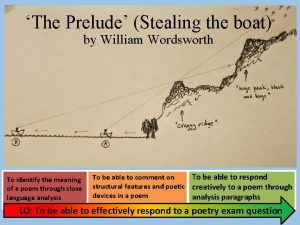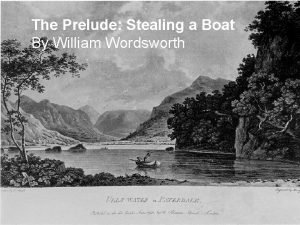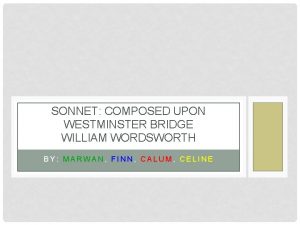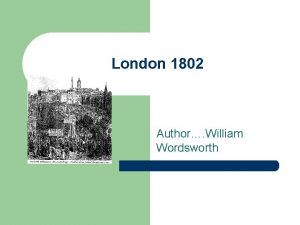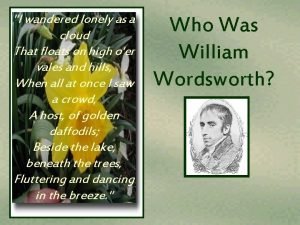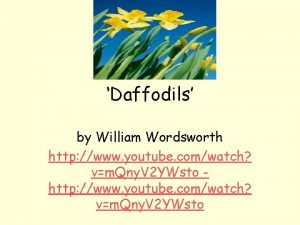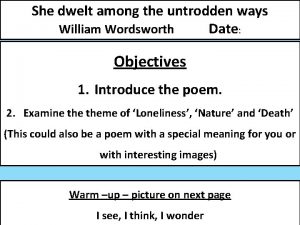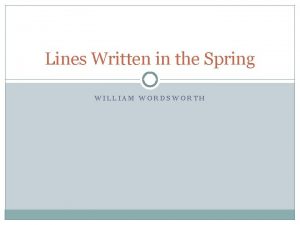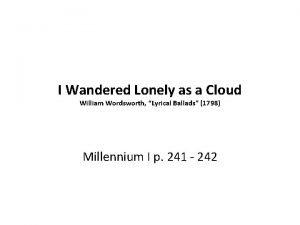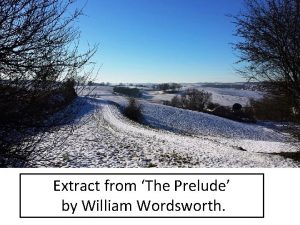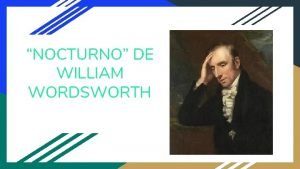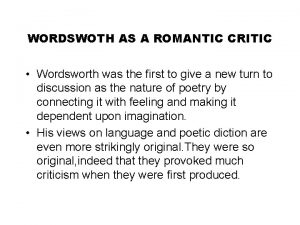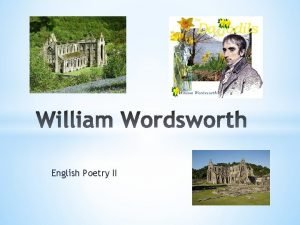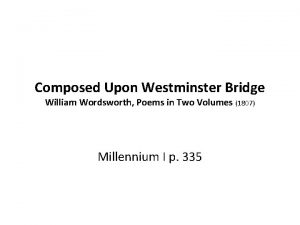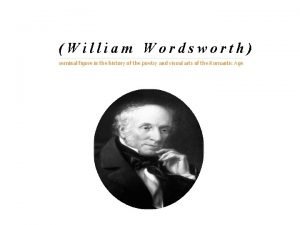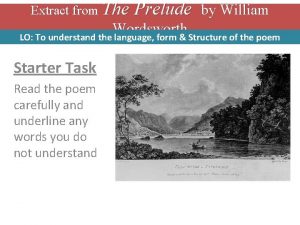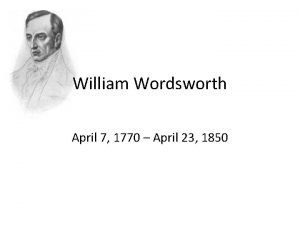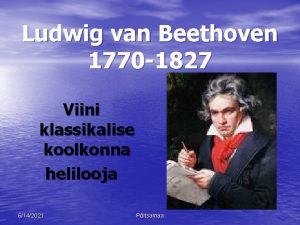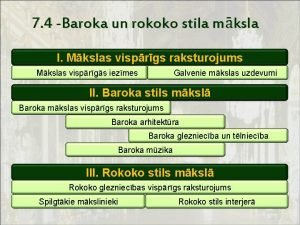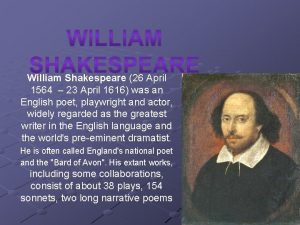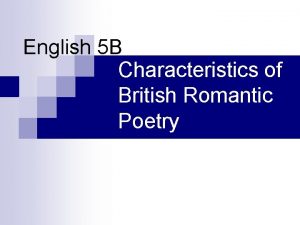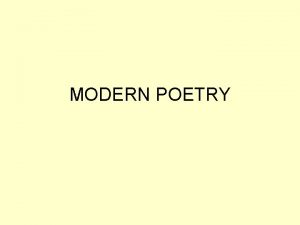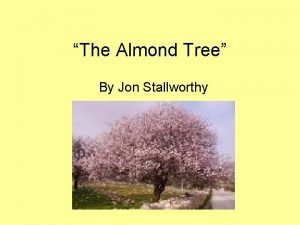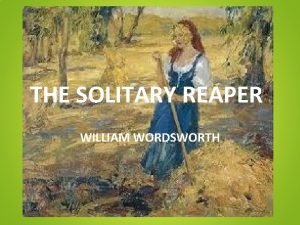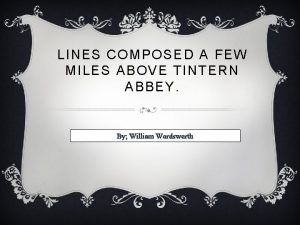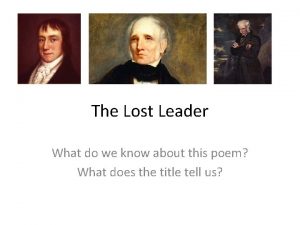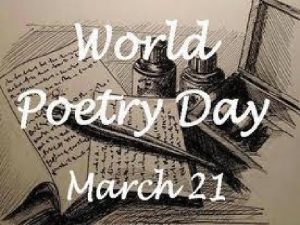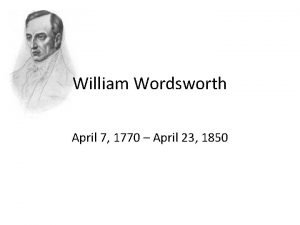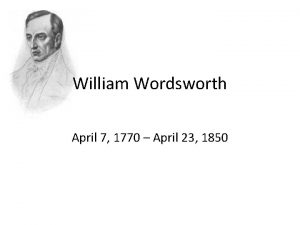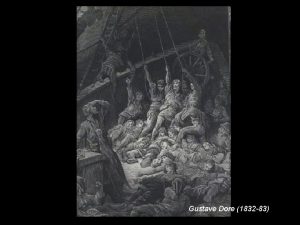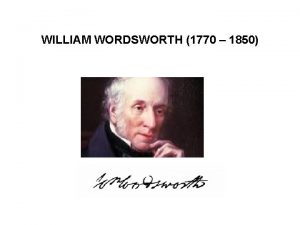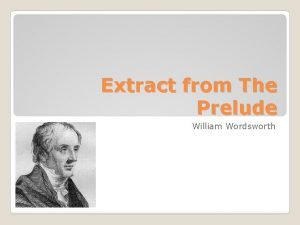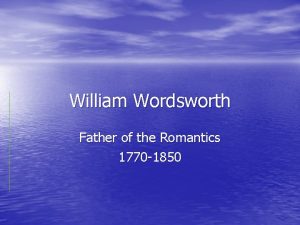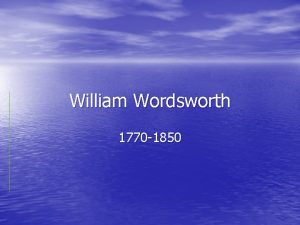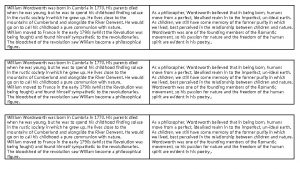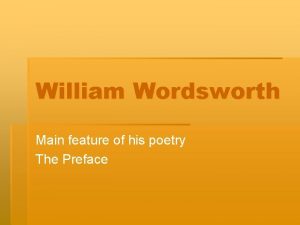English Poetry II William Wordsworth 7 April 1770














































- Slides: 46

English Poetry II

William Wordsworth (7 April 1770 – 23 April 1850) was born near Cumberland, part of the Lake District in the North of England. His sister Dorothy was born the year after and they were extremely close throughout their lives.

In 1787 he attended Cambridge University and received a BA. After he graduated he took an extensive walking holiday throughout Europe. He travelled through Italy, France and Switzerland.

In 1791, whilst in France he became involved in the French Revolutionary Movement. He met a Frenchwoman Annette Vallon and fell in love. They had a child, Caroline, together.

Due to lack of money and the tensions between France and England, Wordsworth left France without Caroline and Annette. However, later he supported them financially. But they were never to live as a family.

In 1795, Wordsworth met Samuel Taylor Coleridge. He was a fellow poet and their friendship greatly influenced the Romantic Movement. In 1798, together they published Lyrical Ballads. This volume of poetry is regarded as launching the Romantic Movement.

In 1800, Wordsworth and his sister Dorothy moved back to the Lake District. There he met with other poets and they were often called ‘The Lake Poets. ’ In 1802, Wordsworth married Mary Hutchinson, a childhood friend. They had 5 children, although 3 died at a young age.

Wordsworth continued to publish poetry to critical acclaim. In 1843, he became the Poet Laureate of England. In 1850, Wordsworth died form pleurisy (an inflammation of the lungs).

That year, his widow Mary published his final work The Prelude. This came to be regarded as his masterpiece. William Wordsworth is regarded as one of England’s greatest poets. His poems changed poetry and literature.

In 1798, ‘Lyrical Ballads, with a Few other Poems’ was published. Most of the poems were written by Wordsworth but Samuel Taylor Coleridge contributed 4 poems. This included ‘The Rime of the Ancient Mariner. ’

It marked the beginning of the English Romantic Movement and changed the course of English poetry and literature. In the 1800 edition, Wordsworth added a preface which explained his and Coleridge’s poetic principles.

They wanted to end the 18 th century style of poetry. They thought it had too many rules and relied too much on Classical times (the Roman and Greek era). They wanted poetry to be written in a style that reflected everyday language and people.

A main theme of the Lyrical Ballads was the return to the original state of Nature, where people lived more natural and innocent lives. Here Wordsworth also defined poetry as “the spontaneous overflow of powerful feelings: it takes its origin from emotion recollected in tranquillity. ”

The poem's full title is "Lines written a few miles above Tintern Abbey, on revisiting the banks of the Wye during a tour, July 13, 1798". Although it is often abbreviated to ‘Tintern Abbey’ or ‘Lines. ’ It is the final poem in ‘Lyrical Ballads. ’

Tintern Abbey is located in Monmouthshire, Wales and was abandoned in 1536. An abbey is a monastery. The area is considered to be an extremely beautiful part of the Welsh and English countryside.

The poem describes Wordsworth’s second trip to this area with his sister Dorothy. Wordsworth's descriptions of the River Wye and the countryside outline his general philosophy on nature. Wordsworth first visited in August 1793 when he was 23. His life had changed a lot since then, he had left his French lover and their illegitimate daughter. Later that year Britain would declare war on France so Wordsworth could not be with his family.

Lines 1 -8: Wordsworth tells us 5 years have passed since he visited Tintern Abbey and the river Wye. But he still remembers the sound of the water coming from the springs. He has returned to this impressive place and sees the cliffs again. He describes the scene’s effect, they impress upon him “thoughts of a more deep seclusion. ” (7) Line 9 -15: He sits underneath a tree (sycamore) and looks at the scene. There are cottages and orchards which have lots of unripe, green fruit on them.

Line 15 -17: He describes how he sees the pastoral (countryside) farms and hedgerows. Line 17 -23: The farms are a green colour and he sees smoke rising up from their chimneys in silence. He speculates how there might be a homeless person or a hermit living in the woods sitting alone in front of a fire.

Lines 23 -5: He then describes how his memory of these “beauteous forms” (23) has effected him in their absence from him. They are not like a landscape to a blind man (i. e. they cannot be seen), instead he sees them very clearly. Line 25 -29: When he was alone or in crowded towns and cities and he felt tired, these memories provided him with good feelings in his heart and body. “…sensations sweet, /Felt in the blood, and felt along the heart. ” (27)

Line 29 -36: The memory of the woods and cottages offered “tranquil restoration” (31) or quiet comfort to his mind. The memories even sometimes affected him when he was not aware of it, these are the “unremembered pleasures” (32). For example, they influenced his behaviour so he would perform little acts of kindness and love. “As may have had no trivial influence” (33) means that it WAS very influential in his life!

Line 36 -42: He continues to credit the memory of this scene with offering him another, sublime gift (36 -8). This memory has given him access to a mental and spiritual state which makes the burden of the world lighter. The burden stands for the negative things in life like sadness, tiredness etc.

Line 42 -50: This happy mood and relationship with nature will be with him until his death or when he becomes a “living soul” (47). He repeats that this joyful relationship with memory and nature allows people to see into “the life of things” (50) or see life more clearly. Line 50 -57: He begins to consider what it would mean if his belief in his connection to nature were wrong (a vain belief). But he dismisses whether the connection is valid or not and describes the many benefits that his memories of nature have given him.

For example, he has turned to the memory often in times of “fretful stir” (53) or mental suffering. Also when the “fever of the world” or the craziness of the world have weighed heavily on his heart (54 -5). Line 56 -58: He addresses the Wye River: "How oft, in spirit, have I returned to thee / O sylvan Wye!”. He tells us he has often returned to the beautiful memory of river. He calls it “the wanderer through the woods” (57).

Let’s take a look at Part 1 of the worksheet! Q 2: ‘Images’ - This means what objects, colours and ideas he uses to describe the landscape.

Line 59 -62: The speaker describes how some memories are faint and dim but this picture has revived all the previous memories. Line 63 -66: He feels pleasure that this moment will last many years to bring him enjoyable, inspirational thoughts in the future.

Line 66 -76: The speaker acknowledges that he is different now from when he was young. As a boy, he “bounded o’er the mountains” (69) and through the streams and rivers (70). As a child nature made up his whole world, however he ran across nature like a man running from something he fears than running to something he loved (71 -3). His behaviour with Nature was uncontrolled and untamed.

Lines 76 -84: Even though he cannot fully describe himself in his youth he knows that the waterfalls, mountains and woods shaped his passions, his appetites and his love. Lines 85 -93: Now his youth is gone but he does not mourn it. He cannot resume the old relationship with nature, but he has been compensated by a new of set mature gifts. Now he looks at nature “hearing oftentimes/The still, sad music of humanity” (8991). Now he is a sophisticated person with a better understanding of the sadness of humanity, now he feels a deeper, wiser relationship with nature.

Lines 94 -112: Now he can feel the presence of something far more subtle and powerful in the setting suns, oceans and in the mind’s of people. This presence seems to him “a motion and a spirit that impels/All thinking thoughts/And rolls through all things” (100 -2). For that reason, he still loves nature because it anchors his purest thoughts and guards the heart and soul of his “moral being” (112).

Line 112 - 121: The speaker says that even if he did not feel this way or understand these things, he would still be in good spirits. This is because he is in the company of his sister, Dorothy, who is also his “dear, dear Friend” (1167). In her voice and manners he observes his younger self, and sees “what I was once” (121).

Lines 122 -133: He offers a prayer to nature knowing that “Nature never did betray/The heart that loved her” (124). Nature’s power is so strong that it makes the mind resistant to “evil tongues, ” (129) “rash judgments, ” and “the sneers of selfish men, ” (130) and encourages a “cheerful faith” (134). Line 135 -147: The speaker then encourages the moon to shine upon his sister, and the wind to blow against her. He hopes that in the future when his sister is sad or fearful, the memory of this experience will heal her.

Line 147 -152: The speaker says that when he is dead, when he can no longer hear Dorothy’s voice or see her eyes, she can remember this moment when they stood next to the river. Line 152 -6: He asks her to remember the deep love he felt for Nature and how he worshipped Nature almost in a religious way or “with far deeper zeal of holier love” (155 -6).

Line 156 -160: Wordsworth combines their current setting with his sister's future memory of the moment. He hopes she will remember how much the landscape meant to the speaker. He also believes that she will carry the place, the moment and the memory with her in the future.

‘Tintern Abbey’ is written in blank verse, which is unrhymed lines in iambic pentameter (5 iambs). Its style is very fluid and natural. It reads like a piece of prose writing i. e. like a story or even a conversation. But of course the poetic structure is tightly constructed. Wordsworth’s slight variations on the stresses of iambic rhythms are significant.

For example, “Here, under this dark sycamore, and view” (10) does not quite conform to the stress-patterns of the metre. It fits loosely which helps Wordsworth recreate the sounds of natural speech without breaking the metre. Occasionally, divided lines are used to indicate a paragraph break, when the poet changes subjects or shifts the focus of his ideas.

The flow of the writing has been described as that of waves, accelerating only to stop in the middle of a line (caesura). The repetition of sounds and words adds to the ebb and flow of the language (mimicking the waves), which appropriately suggests the ebb and flow of the poet's memories. Wordsworth is also directly connecting Nature with the form of the poem.

The subject of Tintern Abbey is memory— specifically, childhood memories of closeness with natural beauty. This subject is hugely important in Wordsworth’s work. This poem represents the young Wordsworth’s first great statement of his most important theme: the memory of the pure relationship with nature in childhood effects the mind even in adulthood when access to that relationship has been lost.

Also that the mature adult mind offers compensation for the loss of that relationship - the ability to “look on nature” and hear “human music” OR nature’s ability to enrich people’s lives and minds. In his youth he was thoughtless in his relationship with nature. Now five years later, he is no longer thoughtless, but acutely aware of everything the scene has to offer him.

But Wordsworth seems to value this earlier period of his life, and remembers it with a somewhat nostalgic air, although it was a simpler time "The coarser pleasures of my boyish days". In the present, he is weighed down by more serious thoughts. He alludes to a loss of faith and a sense of disheartenment. This transition is widely believed to refer to Wordsworth's changing attitude towards the French Revolution.

Wordsworth was inspired by the ideals of the French Revolution. Their emphasis on the value of the individual, imagination and liberty inspired him. But by 1798 Wordsworth was losing faith in the Revolution, as it had degenerated into violence. Eventually Wordsworth was prevented from seeing his family in France and lost his faith in humanity's capacity for harmony. Wordsworth turns to nature to find the peace he cannot find in civilization.

The language of the poem is striking for its simplicity and frankness. The poet is not concerned with ostentation, instead he is concerned with speaking from the heart in a plain manner. The poem’s imagery is largely about the natural world, though there are some metaphors - ranging from the nautical (the memory is “the anchor” of the poet’s “purest thought”) to the architectural (the mind is a “mansion” of memory).

Nature is described with almost religious feeling. He uses words such as "sublime, " "blessed, " and "serene. " Wordsworth refers to a "blessed mood" twice, emphasizing his spiritual relationship with nature. Wordsworth uses many words related to spirituality and religion, but he never refers to God or Christianity. Nature is playing that role in this poem, especially in the second stanza, when Wordsworth describes a sort of transcendent moment:

Until, the breath of this corporeal frame, And even the motion of our human blood Almost suspended, we are laid asleep In body, and become a living soul: While with an eye made quiet by the power Of harmony, and the deep power of joy, We see into the life of things. (Line 44 -50)

Nature offers humankind ("we") a kind of insight ("We see into the life of things") in the face of mortality and death ("we are laid asleep"). Wordsworth emphasises this idea on the last line because it has only eight syllables (four iambs), as opposed to ten syllables. This suggests that it is something important and that he wants us to look at the idea closely.

The connection between religion and nature is also suggested by the speaker’s description of the power he feels in the setting sun and in the mind of man, which consciously links the ideas of nature and the human mind. Wordsworth describes himself as a "worshipper of Nature" (152) with a "far deeper zeal/Of holier love" (154) suggesting that mental images of nature can cause a mystical sensitivity of the divine.

In the previous class I mentioned that The Sublime experience was important to Romanticism. Wordsworth was the most well -known poet to write about the Sublime. In Romanticism, experiencing a sense of awe and terror, anxiety, usually caused by nature, is called the Sublime experience.

Wordsworth finds the sublime in Nature. "Of aspect more sublime; that blessed mood, In which the burden of the mystery In which the heavy and weary weight Of all this unintelligible world, Is lightened (37 -41)” Wordsworth expresses that in the mood of the Sublime, the burden of the world is lifted. He finds awe in the beautiful forms of nature, but he also finds terror. Wordsworth experiences both aspects of the sublime.
 William wordsworth is born in 1770 editing
William wordsworth is born in 1770 editing Wordsworth's definition of poetry
Wordsworth's definition of poetry William wordsworth education
William wordsworth education The world is too much with us paraphrase
The world is too much with us paraphrase Boat stealing poem analysis
Boat stealing poem analysis The prelude analysis
The prelude analysis Wordsworth poem westminster bridge
Wordsworth poem westminster bridge Thou hadst a voice whose sound was like the sea
Thou hadst a voice whose sound was like the sea William wordsworth
William wordsworth Poem of daffodils by william wordsworth summary
Poem of daffodils by william wordsworth summary The tables turned analysis
The tables turned analysis Lucy she dwelt among the untrodden ways
Lucy she dwelt among the untrodden ways Lines written in early spring stanza wise explanation
Lines written in early spring stanza wise explanation I wandered lonely as a cloud stanza 1
I wandered lonely as a cloud stanza 1 Excerpt from the prelude analysis
Excerpt from the prelude analysis William wordsworth daffodils
William wordsworth daffodils William wordsworth writing style
William wordsworth writing style Oxymoron in the world is too much with us
Oxymoron in the world is too much with us William wordsworth nocturno
William wordsworth nocturno Sunovrati analiza pjesme
Sunovrati analiza pjesme Wordsworth as a romantic critic
Wordsworth as a romantic critic William wordsworth is known as a
William wordsworth is known as a William wordsworth profile
William wordsworth profile Westminster bridge william wordsworth
Westminster bridge william wordsworth Who is he?
Who is he? The prelude extract
The prelude extract Wordsworth poetry
Wordsworth poetry 1770 1827
1770 1827 1770-1827
1770-1827 Baroka glezniecība
Baroka glezniecība 1770 james cook
1770 james cook 1770-1827
1770-1827 Beethoven was born in bonn germany in 1770
Beethoven was born in bonn germany in 1770 1827-1770
1827-1770 Hegel 1770 a 1831
Hegel 1770 a 1831 Shakespeare april 23
Shakespeare april 23 April 23rd of 1616
April 23rd of 1616 Characteristics of william blake poetry
Characteristics of william blake poetry Metaphysical and cavalier poets
Metaphysical and cavalier poets Experimentation in modern poetry
Experimentation in modern poetry Lyric poetry definition
Lyric poetry definition Augustan age and romanticism
Augustan age and romanticism Almond tree poem
Almond tree poem Wordsworth solitary reaper
Wordsworth solitary reaper Tintern abbey tone
Tintern abbey tone Dr helen wordsworth
Dr helen wordsworth The lost leader robert browning analysis
The lost leader robert browning analysis

